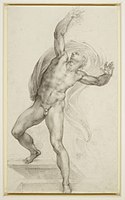
Leonardo di ser Piero da Vinci was an Italian polymath of the High Renaissance who was active as a painter, draughtsman, engineer, scientist, theorist, sculptor, and architect. While his fame initially rested on his achievements as a painter, he also became known for his notebooks, in which he made drawings and notes on a variety of subjects, including anatomy, astronomy, botany, cartography, painting, and paleontology. Leonardo is widely regarded to have been a genius who epitomized the Renaissance humanist ideal, and his collective works comprise a contribution to later generations of artists matched only by that of his younger contemporary, Michelangelo.

Raffaello Sanzio da Urbino, better known as Raphael, was an Italian painter and architect of the High Renaissance. His work is admired for its clarity of form, ease of composition, and visual achievement of the Neoplatonic ideal of human grandeur. Together with Leonardo da Vinci and Michelangelo, he forms the traditional trinity of great masters of that period.

Hans Holbein the Younger was a German-Swiss painter and printmaker who worked in a Northern Renaissance style, and is considered one of the greatest portraitists of the 16th century. He also produced religious art, satire, and Reformation propaganda, and he made a significant contribution to the history of book design. He is called "the Younger" to distinguish him from his father Hans Holbein the Elder, an accomplished painter of the Late Gothic school.

Renaissance art is the painting, sculpture, and decorative arts of the period of European history known as the Renaissance, which emerged as a distinct style in Italy in about AD 1400, in parallel with developments which occurred in philosophy, literature, music, science, and technology. Renaissance art took as its foundation the art of Classical antiquity, perceived as the noblest of ancient traditions, but transformed that tradition by absorbing recent developments in the art of Northern Europe and by applying contemporary scientific knowledge. Along with Renaissance humanist philosophy, it spread throughout Europe, affecting both artists and their patrons with the development of new techniques and new artistic sensibilities. For art historians, Renaissance art marks the transition of Europe from the medieval period to the Early Modern age.
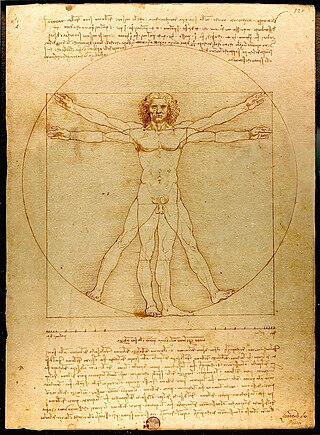
The Vitruvian Man is a drawing by the Italian Renaissance artist and scientist Leonardo da Vinci, dated to c. 1490. Inspired by the writings of the ancient Roman architect Vitruvius, the drawing depicts a nude man in two superimposed positions with his arms and legs apart and inscribed in both a circle and square. Described by the art historian Carmen C. Bambach as "justly ranked among the all-time iconic images of Western civilization," the work is a unique synthesis of artistic and scientific ideals and often considered an archetypal representation of the High Renaissance.

In art history, "Old Master" refers to any painter of skill who worked in Europe before about 1800, or a painting by such an artist. An "old master print" is an original print made by an artist in the same period. The term "old master drawing" is used in the same way.

The Princes Czartoryski Museum – often abbreviated to Czartoryski Museum – is a historic museum in Kraków, Poland, and one of the country's oldest museums. The initial collection was formed in 1796 in Puławy by Princess Izabela Czartoryska. The Museum officially opened in 1878.
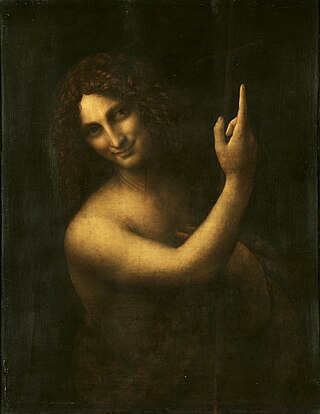
Saint John the Baptist is a High Renaissance oil painting on walnut wood by Leonardo da Vinci. Likely to have been completed between 1513 and 1516, it is believed to be his final painting. Its original size was 69 by 57 centimetres.
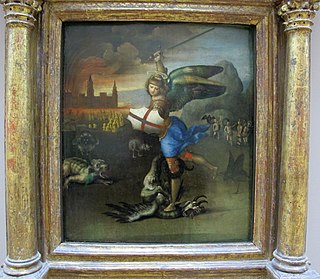
St. Michael Vanquishing Satan is a painting by the Italian High Renaissance artist Raphael. The image consists of the archangel Michael standing on top of Satan's back with his right foot. Both works have been located in the Louvre in Paris since 1667. The painting was commissioned by Pope Leo X.
The decade of the 1490s in art involved some significant events.

The Royal Collection of the British royal family is the largest private art collection in the world.

The artists of the Tudor court are the painters and limners engaged by the monarchs of England's Tudor dynasty and their courtiers between 1485 and 1603, from the reign of Henry VII to the death of Elizabeth I.

The story of Leda and the Swan was the subject of two compositions by Leonardo da Vinci from perhaps 1503–1510. Neither survive as paintings by Leonardo, but there are a number of drawings for both by him, and copies in oils, especially of the second composition, where Leda stands.
John Chamberlaine was an antiquary and acted as keeper of George III's drawings, coins and medals from 1791 until his death in 1812. He published prints of drawings in the Royal Collection by Holbein, Leonardo, Annibale Carracci and others, for which Francesco Bartolozzi (1728–1815) the engraver and etcher, was commissioned as a printmaker.
Priscilla Jane Stephanie, Lady Roberts,, known as simply Jane Roberts, was the Curator of the Print Room at Windsor Castle from 1975 and the Royal Librarian from 2002 until her retirement in July 2013.

The portrait of a man in red chalk in the Royal Library of Turin is widely, though not universally, accepted as a self-portrait of Leonardo da Vinci. It is thought that Leonardo da Vinci drew this self-portrait at about the age of 60. The portrait has been extensively reproduced and has become an iconic representation of Leonardo as a polymath or "Renaissance Man". Despite this, some historians and scholars disagree as to the true identity of the sitter.
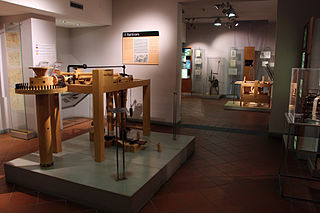
The Museo Ideale Leonardo da Vinci is located in Vinci, Leonardo da Vinci's birthplace, in the province of Florence, Italy. It is part of the Museo Leonardiano di Vinci.

Martin Clayton, LVO, FSA, is Head of Prints and Drawings for Royal Collection Trust at Windsor Castle. He is a specialist in the drawings of Leonardo da Vinci.

The Bridgewater Madonna is a religious painting by Raphael, dated 1507. Originally on oil and wood, but later transferred to canvas, it measures 81 by 55 cm. The picture is part of the permanent collection of the Scottish National Gallery in Edinburgh, on loan from the Duke of Sutherland Collection.



